
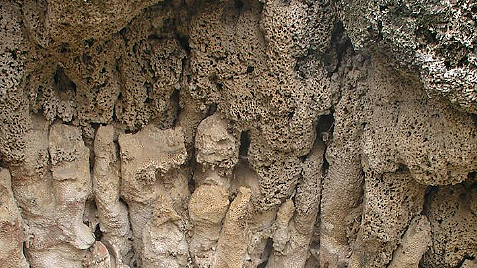
Smith scientists are intrigued by the unusual serpulid-tufa bioherms that developed during the early Holocene Epoch on the hard substrate of pre-existing coral deposits near the periphery of Lake Enriquillo in the Dominican Republic.
/ Published June 5, 2013
Eight years ago, Smith student Kelsey Winsor was part of a team of American undergraduates and professors participating in a summer geological study in the Enriquillo Valley, a remote area of southwestern Dominican Republic. The valley is a small, tropical version of Death Valley, with much of its area below sea level and its lowest part covered by hypersaline Lake Enriquillo (a wet equivalent of Death Valley’s salt pan bottom). There she teased new clues from fossilized rock mounds about the convergence of environmental conditions on Earth during the Holocene Epoch (the most recent 10,000 years of geological time leading up to the present).
Winsor is still stirred by the vivid details of that fieldwork: the arid landscape of the Enriquillo Valley, extreme Caribbean heat and the startling sight of large and complex carbonate mounds—the bioherms—which over the years have drawn the curious as well as the scientific. The unusual rock mounds are guarded by stands of native cacti, which “stubbornly formed forests around the bioherms we wanted to sample.”
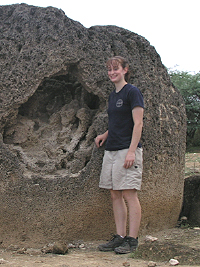
Kelsey Winsor ’07 near a large, isolated serpulid-tufa mound in 2005. Photo by Al Curran. Click to enlarge.
Undeterred, however, Winsor and her team furrowed through rough terrain and sun-scorched cacti to get to those bioherms. And their reward was gaining access to the massive fossil deposits, some of the largest, most distinctive and rare clustered rock masses of this kind, formed several thousand years ago by tiny, tube-building serpulid worms and found only in a handful of places in the world, including this steep-walled valley.
Before her fieldwork in the Enriquillo Valley, Winsor says she had been debating whether to major in philosophy or geology.
Indeed, after completing the fieldwork experience, organized through the Keck Geology Consortium, which was founded in 1987 with Smith as a charter member, Winsor returned to campus with new clarity and embarked on an independent study in the Smith geology department (now geosciences). Over the next year, she performed numerous analyses on the bioherm samples she had gathered in the field and completed an honors thesis on her research before graduating with highest honors and a degree in geology.
Today, Winsor is a doctoral candidate at the University of Wisconsin studying paleoclimatology and paleoceanography. She is also the lead author in a newly published paper in PALAIOS, a prestigious journal directed to a broad-based international audience of sedimentary geologists, detailing the fieldwork and research: “Unusual Holocene Serpulid-Tufa Bioherms, Enriquillo Valley, Dominican Republic: Morphologies and Paleoenvironmental Implications.”
Winsor’s co-authors were Smith geosciences professors H. Allen Curran and Bosiljka Glumac, and Lisa Greer of Washington and Lee University [see sidebar]. Greer completed her doctoral thesis on Enriquillo Valley deposits and, while a graduate student at the University of Miami, introduced Professors Curran and Glumac to the valley on earlier fieldwork expeditions. In the paper, they report descriptions and classifications on not only the composition and morphologies of the bioherms but also assess the paleoenvironmental context for the development of these rock formations.
“With this paper, we answered the most basic questions regarding these unusual bioherms, specifically: what organisms made them? what other processes contributed? what paleoenvironmental controls were operative? and why did they form?” says Curran, who is the William R. Kenan, Jr., Professor Emeritus of Geosciences at Smith.
“The Enriquillo Valley in the southwestern part of the Dominican Republic is geologically very unique and of great interest,” notes Glumac, a sedimentary geologist and professor in the Smith geosciences department.
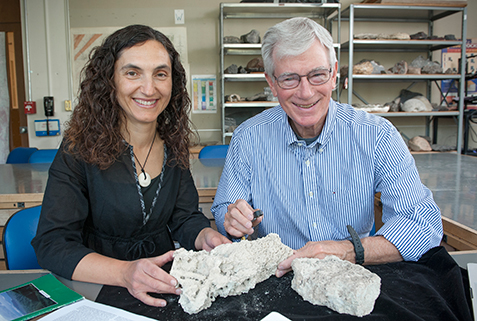
Smith geosciences professors Bosiljka Glumac and Allen Curran.
At the end of the last ice age, about 10,000 years ago, Glumac says, the climate shifted and the Carribean Sea began to flood the Enriquillo Valley; a fringing coral reef flourished along the valley walls in the rising marine waters. But as the environmental changes in climate and sea level continued, sediment from a nearby river flowed in and the coral reefs began to die. About 5,000 years ago the whole valley was cut off from the sea, forming Lake Enriquillo. Subsequently its surface waters evaporated to some 40 meters below sea level.
“Then along come these opportunistic worms. They colonized on top of the dying coral and formed large serpulid bioherms,” Glumac says. “These are rare formations caused by a species of marine worms known to aggregate in waters of abnormal salinity. They secreted calcareous tubes, attaching to the existing coral reef, forming a completely new mass of rock. The worm tubes reached a length of only about 1 to 2 centimeters, but they produced aggregates up to 3 meters (9 feet) in height.”
The attention focused on the bioherms is justifiable because they are “very unique and impressive deposits,” says Glumac. “And because of the cut-off and drying out of the ancient seaway in the Enriquillo Valley, nowhere else in the world have deposits of this type and age been discovered and exposed so well.”
One fieldwork location that holds particular interest for Glumac is Las Caritas, a site situated on a cliff face overlooking Lake Enriquillo. This site has the greatest concentration of Taino petroglyphs carved in the porous carbonate tufa material, which coats the serpulid worm bioherms that the rock face is made of. The face-shaped carvings are considered to be rare archaeological evidence of the Taino Indian people that once inhabited the area.
Although the tufa-coated serpulid mounds provided a truly unique substrate for carving of the Taino petroglyphs, Glumac says it is not possible to directly date the petroglyphs. Therefore, it is uncertain when the activities of carving images on rock surfaces began.
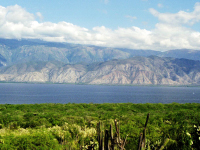
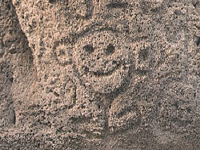
Top: A view toward the north shore of the hypersaline Lake Enriquillo, which is the largest lake and lowest point in the Caribbean. Bottom: The tufa-coated serpulid mounds provided a truly unique substrate for carving of the Taino Indian petroglyphs. Photos by Allen Curran. Click to enlarge.
“These activities may have started soon after the arrival of people to this island between around 4000 and 2000 BC (or about 6000 to 4000 years ago), but most petroglyphs were likely made by the Taino people between about AD 500 and 1492 (or about 1500 to 500 years ago),” Glumac notes. “Although most of the carving activities abruptly ended with the arrival of the Spanish to Hispaniola (the island that today hosts Haiti to the west and the Dominican Republic to the east) in 1492, some of the petroglyphs may have been made between 1519 and 1533 when the Taino, under the leadership of Chief Enriquillo, fled to this inhospitable, arid region that today bears his name (the Enriquillo Valley) during a revolt against Spanish rule (the only successful revolt of its kind).”
An invertebrate paleontologist, Al Curran finds the bioherms important as “an unusual occurrence of the build-ups formed by tube-making serpulid worms. Precipitation of the outer tufa coatings was aided by microbes, and these tufa-coated serpulid mounds are an excellent example of something not typically seen in the geological record.” He has been to the area four times to conduct fieldwork and ongoing invertebrate paleontological research, including the Keck expedition of 2005; Keck funds undergraduate field research by its member schools on projects around the world.
Professors Glumac, Greer and Curran recognized the potential for a scholarly paper in Winsor’s honors thesis, “The Holocene contact between coral colonies and serpulid tube/tufa mounds of the Enriquillo Valley, Dominican Republic: Paleoenvironmental implications.” Manuscript prep initially went slowly after Winsor graduated from Smith, but she persisted and prepared a draft to submit for publication. “This is an example of moving undergraduate research to a higher level,” notes Curran.
“Other researchers who encounter similar deposits in the future will look to this article for answers to fundamental bioherm questions,” Curran says. “That’s why I think our PALAIOS article will have a long shelf life; people will be referring back to this work for many years to come.”
Winsor echoes Curran’s and Glumac’s predictions that the PALAIOS paper will be of ongoing value to other scientists working in similar field sites. “The explanations should help researchers develop an environmental history for similar features, and the classifications will aid in developing a more uniform and systematic means of describing the serpulid-tufa bioherms.”

















